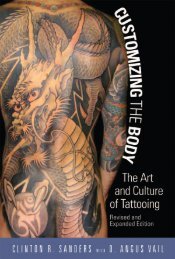Encylopedia of Body Adornment.pdf - Print My Tattoo
Encylopedia of Body Adornment.pdf - Print My Tattoo
Encylopedia of Body Adornment.pdf - Print My Tattoo
You also want an ePaper? Increase the reach of your titles
YUMPU automatically turns print PDFs into web optimized ePapers that Google loves.
INTRODUCTION xix<br />
The differential marking <strong>of</strong> criminals and the lower classes continued into the<br />
twentieth century in many societies, and <strong>of</strong> course the use <strong>of</strong> specialized adornments<br />
among the elites to distinguish themselves from the other classes continues<br />
as well.<br />
In modern society, we see that the desire to mold the body as a sign <strong>of</strong> social<br />
status is unchanged, with men and women using makeup, jewelry, hairstyles, cosmetic<br />
surgery, dieting, and fashion to transform their bodies in accordance with<br />
the current dictates <strong>of</strong> style. Fashionable bodies are young, thin, and beautiful,<br />
and when commonly practiced forms <strong>of</strong> adornment and modification (such as<br />
dieting, makeup, and hairstyling) cannot achieve these characteristics, more extreme<br />
modifications are available to those who can afford them. Full face, hair,<br />
and body makeovers are purchased by the wealthy and are also seen on television<br />
shows like “The Swan” and “Extreme Makeover,” and rely on modern surgical procedures<br />
such as bariatric surgery, cosmetic surgery, cosmetic dentistry, cosmetic<br />
dermatology, and hair implants and weaves.<br />
Also in modern societies, we have seen the development <strong>of</strong> nonnormative body<br />
modifications such as tattooing, piercing, stretching, branding, scarification, and<br />
genital modifications, which allow individuals to step outside <strong>of</strong> the bounds <strong>of</strong> the<br />
normal social order, and mark membership in alternative subcultures, such as bikers,<br />
punks, convicts, gang members, or among those who practice alternative sexualities.<br />
Also in the twentieth century we saw the development <strong>of</strong> a movement that<br />
not only uses nonnormative and <strong>of</strong>ten extreme body modifications but relies on<br />
them for aesthetic, spiritual, sexual, and personal growth. This movement, known<br />
as the modern primitives movement, borrows body modification techniques and<br />
religious and cultural beliefs from non-Western societies to resist and challenge<br />
modern social practices. Ironically, however, while the traditions borrowed in the<br />
modern primitives movement generally serve to mark traditional peoples as belonging<br />
to the social order, those practices, when used in the contemporary West,<br />
serve instead to separate the wearers from society, rather than integrate them. Even<br />
more ironic, perhaps, is the fact that many <strong>of</strong> these traditional forms <strong>of</strong> body modification<br />
have now disappeared from the societies in which they were practiced,<br />
<strong>of</strong>ten stamped out through Western imperialism, and only exist now in cannibalized<br />
form among modern primitives.<br />
According to theorist Michel Foucault, in state-level societies, power is inscribed<br />
on bodies through modes <strong>of</strong> social supervision and discipline as well as<br />
self-regulation. But at the same time, bodies also can be sites <strong>of</strong> resistance as they<br />
always entail the possibility <strong>of</strong> counterinscription, <strong>of</strong> being self-marked. Thus the<br />
use <strong>of</strong> body modifications in ways that are not only not socially sanctioned but<br />
are explicitly antisocial can be seen as a way in which disaffected or marginalized<br />
bodies can mark themselves in accordance with their owners’ self-image.<br />
Contemporary members <strong>of</strong> the body modification movement who use extreme<br />
modifications in nonnormative ways see themselves as taking control <strong>of</strong> their own<br />
bodies and expressing their individual identities. Proponents see these modifications<br />
as ways in which they actively transform the self. However, mainstream society<br />
typically views them in a very different light, and sees them as a disfigurement



